John Perrine is a fifth-year graduate student in wildlife ecology and conservation at the University of California at Berkeley. He is also a researcher at the Berkeley Museum of Vertebrate Zoology and a fellow of the Environmental Leadership Program.
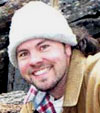
Monday, 23 Jul 2001
MINERAL, Calif.
For many people, a mention of California evokes images of the glamour of Hollywood, the bustling streets of San Francisco, or the sheer weirdness of Berkeley. Others may think first of one of the state’s famous valleys, such as Silicon Valley, the Imperial Valley, the Napa and Sonoma valleys, or Death Valley.
Nearby, and yet a world away, are the majestic ridges of the Cascade and Sierra Nevada mountain ranges. Here, along the spine of the state, dozens of small towns and villages rest among dense evergreen forests. One of the smallest of these mountain hamlets is Mineral, population 90, elevation 4,950 feet. I’m living here while I investigate one of the state’s most beautiful and elusive carnivores, the Sierra Nevada red fox.
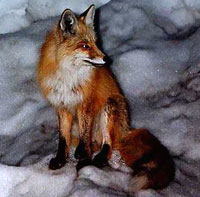
Foxy! The Sierra Nevada red fox.
Photo: John Perrine.
These shy foxes, about the size of a house cat, occur in scattered locations above 4,000 feet in California’s eastern mountain ranges. They are a unique subspecies of the red fox, one of the world’s most widely distributed and well-known carnivores. As a species, red foxes occur throughout North America, Europe, Asia, and Australia, and they have been studied by literally hundreds of scientists. But ironically, virtually nothing is known about the Sierra Nevada red fox, except a handful of museum specimens from the 1920s and a few interviews with fur trappers from the same period.
As more and more people moved to the mountains, drawn by jobs in the timber industry and a peaceful way of life, the mountain red fox was seen less and less. In 1977, state and federal wildlife biologists identified the Sierra Nevada red fox as one of California’s highest research priorities. Three years later, the state wildlife agency listed the fox as a State Threatened Species. Biologists and land managers had little idea how many foxes remained or whether their numbers were increasing or decreasing. Even basic facts about their biology, such as what they eat and how many offspring they have, remained a mystery.
It wasn’t until 1999 that a comprehensive, three-year research project was started to learn more about these mysterious and elusive mountain foxes. Our research team from the University of California at Berkeley, in cooperation with the California Department of Fish and Game, Lassen Volcanic National Park, and the Lassen National Forest, is trying to address and answer many of these long-standing questions. This information is crucial for developing a successful strategy to protect and conserve the Sierra Nevada red fox.
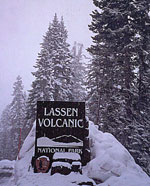
Snowy California.
Photo: John Perrine.
Lassen Volcanic National Park is less well-known than her sisters to the south, Yosemite National Park and Sequoia & Kings Canyon National Parks. As its name implies, Lassen Volcanic National Park contains an impressive array of geothermal features, including steam vents, mud pots, lava beds, and volcanic cinder cones. Towering over the Park is Lassen Peak, an imposing volcanic dome more than 10,450 feet high. Its snowy peak bears silent witness to the powerful geological forces that shaped much of Northern California.
The park is surrounded by the Lassen National Forest. Together, they contain nearly a thousand square miles of habitat for a wide range of wildlife. Of the 20 species of terrestrial carnivores native to California, all but four (kit fox, island fox, fisher, and wolverine) can routinely be found in the Lassen region. Much of the area remains as wild and rugged as it was before the white men arrived. Standing on a secluded ridge, it is easy to forget the rampant population growth and resource consumption that typifies so much of California.
Our tiny research team is trying to answer a wide array of questions. How do the foxes find food in the winter when snow can pile to 30 feet or deeper? How much area does a single fox use in a day, over a season, or throughout its whole life? How long do the foxes live? What kind of habitat do they use for hunting and for raising their pups? Are they territorial like red foxes in other areas and, if so, how big are the territories? And what do we need to do to ensure the survival of these unique and fascinating animals?
Over the next few days, I invite you to accompany me — and my field assistants, Kristin, Whitney, and Samantha — as we use modern technology and good old-fashioned legwork to learn more about the elusive Sierra Nevada red fox.
Tuesday, 24 Jul 2001
MINERAL, Calif.
Why do certain animals occur in some places and not in others? This question, one of the oldest in science and natural history, still has bearing on wildlife research today. Every species is adapted for certain habitats or environments, and we would expect to find that species there and not in other places. Likewise, when habitats disappear or are destroyed, the species living there may disappear as well. Determining the relationship between a species and its habitat is a fundamental step in conserving both.
In our ongoing study of the threatened Sierra Nevada red fox, one of our primary goals is to learn where foxes occur and where they don’t. This would suggest that one habitat is “good” for foxes and that the other is “bad.” In reality, the situation is a bit more complex — a perfectly good habitat just might not have any foxes in it right now — but we have to start somewhere.
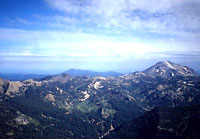
An aerial photo of Lassen Volcanic National Park showing various habitats.
Photo: John Perrine.
º? {?ch sites, Lassen Volcanic National Park and the surrounding Lassen National Forest, lie at the southernmost tip of the Cascades Mountains in Northern California. Together, the park and the forest contain more than a thousand square miles of wildlife habitat: barren rocky slopes, dense conifer forests, lush mountain meadows, bubbling streams, and fields of scrubby brush.
To find our foxes, we are using TrailMaster automatic camera stations — perhaps one of the most promising and downright-fun new wildlife research tools to come along in decades. The stations consist of a motion detector wired to a simple point-and-shoot camera. The motion detector works just like the sensor on a back-porch light: When something comes walking along, it activates the motion sensor. In our case, instead of turning on a light, the sensor triggers the camera to take a photo. All we have to do is nail the sensor and camera to a tree and then come back in a week to see what critters happened to wander by.
To increase our chances of finding foxes, we put out some bait we hope will draw them to within range of the cameras. It’s like a biz
arre combination of security technology and fishing. Our current bait is rancid chicken legs, sprinkled with a little commercial trapper’s scent-lure and a splash of red fox urine (you can order it by the bottle if you’ve got the right catalogs). The overall effect is somewhat overpowering. We don’t know if the foxes find the smell delicious or appalling, but one way or another, it brings them in from miles around.
At any given time we’ll have about 10 camera stations scattered throughout the park and the forest, in a variety of different habitats. Some of these stations will detect Sierra Nevada red foxes and others will not. Gradually a pattern emerges, indicating which habitats are likely to contain red foxes and which are not. It may also tell us how many individual foxes are in a given place at the same time, and whether they seem to be found in the same habitats as other species such as bears, coyotes, and bobcats.
It takes a team of two people at least a full day to check and rebait all the stations. Generally, one person changes the film and the batteries in the camera while another person sets out the bait. This keeps the bait smell from getting on the equipment, which seems to help stop the bears from eating our cameras. Checking cameras really illustrates the glamour inherent to wildlife biology: There’s nothing like wiring some stinky, greasy, maggot-ridden chicken to a tree and then sprinkling it with fox pee — especially right before lunch.
The real fun is getting the pictures developed and seeing just what animals came by our station in the last week. Was it a fox? A bear? A bobcat? Unfortunately, we have to wait until the end of the week before we get our pictures back.
Wednesday, 25 Jul 2001
MINERAL, Calif.
The western half of Lassen Volcanic National Park is probably the shattered rim of an ancient giant volcano that exploded thousands of years ago, showering debris across much of Northern California. Today the area is all rocky ridges and steep slopes. Mountain hemlocks and tangled whitebark pines dot the jagged mountain cliffs, while steam vents and boiling mudpots line the valleys. A single, two-lane road snakes its way from the park’s southwest entrance, at about 6,000 feet, up along the ridges to the foot of Mount Lassen, at 8,500 feet, and then back down to the dense evergreen forest on the other side.
Part of our research project involves following a handful of Sierra Nevada red foxes so we can learn how they live in this rugged environment. The phrase “breathtaking landscape” takes on new meaning if you’re on foot chasing after a mountain red fox as it hunts its prey. The foxes are active mostly at night, so chasing them around as they conduct their business is no simple undertaking even without the cliffs and valleys.

Me, conducting telemetry in Lassen Park.
Photo: Tom Rickman, US Forest Service.
Instead of following the foxes by sight, we track them by using radio telemetry. Every red fox in our study has a powerful radio-transmitter collar around its neck. Each fox transmits on its own radio channel, so we can dial in any particular fox on our hand-held receivers. We have hand-held antennas that look like tiny old-fashioned TV aerials, and the radio signal is loudest when we point the antenna directly toward the fox we’re tuned to. By going to several different places in the course of an afternoon and noting the strength and direction of the radio signal at each place, we can calculate an approximate location for that fox without ever seeing it or disturbing its activities. We can also track them from a small airplane equipped with antennas on its wings.
We check in on our foxes several times a week, usually on Mondays, Wednesdays, and Fridays, varying among morning, afternoon, and night. Over the course of a season, we calculate dozens of locations for each fox, slowly building up a picture of how each animal uses the landscape. The process works well and has been a critically important tool for wildlife biologists for the past three decades.
The real trick is getting the radio collars on the foxes in the first place. We catch the foxes using a wire cage trap the size of a dorm mini-fridge. We set out a dozen or so of these cage traps throughout Lassen Park and the Lassen National Forest, baiting each one with a chicken leg and some scent lure. The foxes are not abysmally stupid, so they avoid these traps like the plague. But eventually hunger and curiosity overwhelm a fox’s judgment, and it darts inside the trap, grabs the bait, and runs away. The trap doesn’t catch the fox because we wire the trap door open for the first few weeks. This lets the fox overcome its fear of this odd contraption that has suddenly appeared in its backyard.
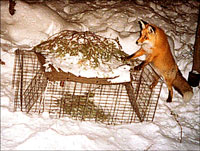
Red fox avoiding capture in our box trap.
Photo: John Perrine.
After about two weeks, the fox learns that the contraption seems to have new chicken legs in it every night, free for the taking. Then we remove the wire that holds the trap door open, and, hopefully, the next morning we’ve caught a fox. It’s a neat trick when it works, which is about two times out of 100. More often, we’ll catch a pine marten or a skunk or something else unintended, or the bait will be stolen without catching anything at all. Or, we’ll catch the same fox over and over, because it’s happy to spend the night in our cage munching on a chicken leg.
Because these mountain red foxes haven’t been studied since the 1930s, the rare occasions that we actually capture a new red fox generate a flurry of activity. We use a special handling bag to remove the fox from the cage, and then we give it a thorough medical exam to make sure it’s not injured. We determine its sex and, for a female, whether she has recently reproduced. We weigh it and measure it and make notes about its teeth and its color patterns and anything else that seems relevant. We take some blood and a genetic sample, attach the radio collar and a numbered ear tag, and then set the fox free as quickly as possible.
Since the spring of 1998, we’ve caught a grand total of one male and four female red foxes. That’s about a quarter of the number we had hoped to catch, but it’s a starting point. Ironically, although the foxes seem abundant in the Lassen area compared to other places in the Cascades and Sierra Nevada mountains, they are still few and far between here.
We’ve tracked some of our foxes for several years, giving us great insight into how they use their habitat and respond to changes in the seasons. This information adds critical pieces to the puzzle of how we can ensure that these fascinating animals survive well into the future. On Friday, I’ll summarize the picture that’s beginning to emerge.
Thursday, 26 Jul 2001
MINERAL, Calif.
Sometimes I wonder why I ever answer the phone.
As a field biologist and graduate student, I am rarely in the office to answer phone calls. But this summer, I’m lucky to have three great field assistants to help me out. When Samantha, Whitney, and Kristin are in the field, checking our camera stations and conducting radio telemetry, I get a chance to catch up on office logistics.
Then the phone rings, and against my better judgment, I answer it. One of our radio-collared red foxes is begging at a parking lot. The fox is going right up to visitors like she owns the place, sneaking sandwiches from backpacks when no one is looking, and generally being a nuisance. Can’t we do something about it?
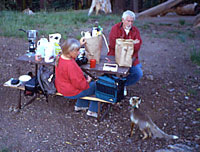
The red fox begging at a campsite.
Photo: John Perrine.
Photo: John Perrine.
This is an awkward situation. The Sierra Nevada red fox is one of California’s rarest and most elusive carnivores. Most people who live in the mountains of Northern California will never see one. The state has classified them as a threatened species. Furthermore, our study animals in Lassen Volcanic National Park, like all wildlife in all national parks, are fully protected from hunting or harassment by federal law. And yet there’s our fox, trotting from car to car like a prostitute working her block of the red-light district.
Wildlife viewing is one of the main reasons why people come to the national parks. Unlike a zoo, a national park really gives visitors a chance to see animals behaving naturally in their natural environment. Yet even in the park an invisible line between humans and wildlife remains. Once that line is crossed and an interaction occurs, the result is almost always negative, especially for the animal.
Red foxes are opportunistic, meaning they will learn to take food any way they can get it. In the course of a single, evening a fox may stalk and capture a field mouse, scavenge a road-killed bird, nibble berries from a bush, or root through a garbage can for chicken bones. Their adaptability has been one of the keys to their success and is one of the main reasons why they are one of the world’s most widely distributed terrestrial carnivores. Yet this adaptability can also be an Achilles heel.
Our beggar fox probably learned her errant ways in the wintertime, when deep snow blankets the landscape and food is scarce. Under these harsh conditions, the lure of food scraps in trash cans overwhelm her natural fear of human scent. Eventually, she learns that scrounging food from parking lots and campsites carries a rich reward with very little risk. Sloppy and thoughtless campers encourage this behavior by leaving their food unattended or, even worse, feeding her so they can get a photograph.
The result is trouble for both the visitors and the fox. The visitors risk an expensive ticket from the park rangers or a nip by the fox if they get too close. The stakes are higher for the fox, of course. Some human foods, such as chocolate, can kill a fox, and by hanging around the roads and parking lots she greatly increases her risk of being hit by a car. And if she nips a visitor, even someone who is foolhardy enough to try to feed her by hand, she will have to be shot.
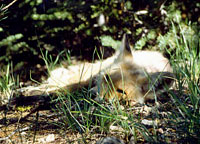
A fox napping beneath a red fir.
Photo: John Perrine.
No one wants this to happen and the key is education. We are putting up signs and distributing handouts telling park visitors not to feed the fox. The park rangers are keeping a close eye on the parking lot and are ready to write tickets to anyone who still hasn’t gotten the message. Educating the fox is a tougher proposition. Now that she has learned to associate parking lots and humans with food, unlearning this behavior will be much more difficult. Problem bears can be sprayed with pepper spray or shot with paint balls as a deterrent, but the threatened status of the foxes requires more delicacy. The park rangers have bought some Super Soaker water guns so they can give a begging fox a wet surprise, much like you’d spray a cat for jumping onto your kitchen table.
Luckily, the vast majority of the park visitors don’t feed the foxes. Likewise, most of the foxes don’t beg at parking lots. But it only takes one or two bad apples on both sides for the trouble to begin. When that happens, my phone starts ringing. Thank God for voice mail.
Friday, 27 Jul 2001
MINERAL, Calif.
Fridays are a good day to look back over the week, literally, because on Fridays we get our photos back from the TrailMaster automatic camera stations that we checked on Tuesday.
We had four pairs of camera stations set out in Lassen Volcanic National Park and the surrounding Lassen National Forest, so we had eight rolls of film developed. Flipping through the photos for the first time is like opening Christmas presents: You never really know what you’re going to get, and the initial suspense and excitement are often followed by disappointment.
Here’s a usual batch of photos: One shot of me looking dorky as I make sure the equipment is working right. Five shots of the bait drying in the sun. Two shots of a squirrel checking out the bait drying in the sun. A bird. Squirrel, squirrel, squirrel. A close-up of a deer’s butt at 2 a.m. Five shots of the bait glistening in the dawn. More squirrels. Then finally, maybe, something interesting, like a bear or a pine marten or even one of the Sierra Nevada red foxes we’re looking for. Then more shots of deer or squirrels and a final picture of something that looks like a supernova, which happens when a camera’s batteries die.
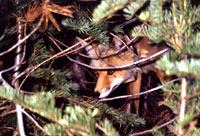
Red fox peering out of red fir grove.
Photo: John Perrine.
This week’s photos are par for the course, except for one neat photo of a coyote. Of our eight camera stations, only one photographed a red fox. On one hand this is good, because we knew one of our collared red foxes was in that area — and the camera station detected it. But on the other hand there don’t seem to be any red foxes in other places. This is our second summer using these camera stations, and we have yet to detect a red fox outside of Lassen Park.
What does it all mean? At this stage of the game, we’re flying a bit blind, like assembling a jigsaw puzzle without looking at the photo on the box. But, eventually, a picture will begin to come together. Our five radio-collared foxes have taught us that, in the summertime, each red fox has its own territory of about four square miles. That’s a lot of turf for an animal the size of a house cat. This implies that one fox needs that much space to find enough food and other resources to keep it alive. In the wintertime, our collared foxes leave Lassen Park entirely, heading south into Lassen Forest. The one collared fox that didn’t move out of the park didn’t survive the winter. This suggests that, once the snows start, the foxes just can’t make a living at the higher elevations in the park. Once the snows melt in the spring, though, the foxes head right up to the park, often to the same places where they spent the previous summer. The photos from our camera stations support this pattern of seasonal movements: In the summer, we detect a few foxes in the park and none in the forest, while in the winter, we detect those same foxes down on the forest instead of up in the park.
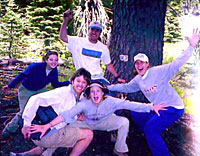
Clockwise from top: John Perrine, Whitney Meno, Kristin Young, Frank Wolff (a researcher from Europe visiting for the day), and Samantha Ratti.
Photo: John Perrine.
Maybe this movement pattern is driven by a lack of food. Maybe it’s driven by competition with bigger carnivores, such as coyotes and bobcats, both of which may kill red foxes. Or maybe it’s something else entirely. But the end result is that
there aren’t nearly as many red foxes in the Lassen area as we thought. Any management plan to conserve these rare foxes is going to have to take into account the foxes’ seasonal movements among the national park, national forest, and private lands.
Science is an iterative process: You start with a question, collect some data to address that question, and, in the process, often end up with more questions. As with all environmental problems, from imperiled species to urban sprawl to global climate change, good information is critical to making intelligent policy decisions. Our three-year study of the Sierra Nevada red fox is the first ecological research ever conducted on this elusive mountain carnivore, and it may well raise a lot of new questions. But our results will shed invaluable light on what steps should be taken to ensure the survival of these beautiful and fascinating animals.

